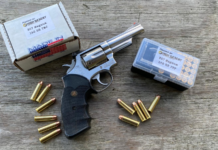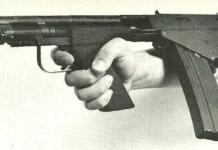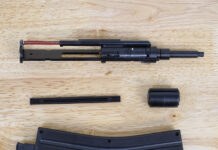
Introduction
Reporting the news, when it comes to stories involving firearms, can be extremely complicated. There are many commonly used words and phrases that one would assume are accurate, but are often not at all. The sources of these descriptions, definitions, and sayings can range from politicians, to the military, to governments, NGO’s, activists, and other news outlets, but not all of these sources are created equally when it comes to terms being properly stated, or even relevant to the story. With the advent of the 24 hour news cycle, priority is often given to speed over accuracy. This can often lead to incorrect information being disseminated, which usually leads to misconceptions being exaggerated and duplicated by other news outlets and social media.
This paper will attempt to address many of the misconceptions and misuses of the terminology often used to describe various aspects of firearms and firearm related law in order to add clarity and accuracy to news writing and reporting.
Definitions
Definitions are extremely important to being factual, as are the sources of those definitions. When in doubt, it is best to refer to either government or military sources, scientific studies and journals. Other sources may include firearm history books, or firearm industry publications. Wikipedia, though it is not preferred in academia, is usually accurate and can be used if expediency is necessary, which usually is the case when it comes to news reporting, but be sure to check the citations.
Assault Rifles
The first definitions that are the most important to understand is the difference between ‘assault rifles’ and ‘assault weapons’. Assault rifles, as defined by the ATF as well as the UN Small Arms survey of 2013 are, “light, self loading rifles that are chambered for intermediate calibre cartridges, such as 5.56×45 mm or 7.62×39 mm. Designed to engage targets at ranges rarely exceeding 400 metres (around 1,300 feet), they are primarily selective-fire weapons, enabling the user to switch between single-shot, fully, automatic, and (in some models) burst-fire modes of operation” (United Nations, 2013).
These fully automatic firearms are highly regulated by the federal government and banned by a number of state governments. The 1986 FOPA bill (Firearms owners protection act, 1986) restricted the number of fully automatic firearms (FA firearms) so that no new ones could be produced and sold to civilians after May 19th, 1986. This limited the number of FA firearms to around 250,000, increasing their value due to supply and demand so that the firearms that can be legally transferred between private citizens ranges from $5,000 to over $100,000. In order to legally transfer an FA firearm, a buyer must fill out an ATF Form 4, pay a $200 tax, and register the firearm in the state where it is legal to own. People can often confuse the ‘AR’ in AR-15 to mean ‘Assault Rifle’-15, this is not the case. The ‘AR’ stands for Armalite Rifle, the company who first produced the firearm (Armalite, 2015).
It’s important to understand the rarity and expensive nature of FA firearms when talking about their usage in crime. According to Dr. Gary Kleck, a criminologist and authority on gun crime in the US, there have been less than 10 crimes committed with legally owned machine guns since 1934 when they were first regulated by the National Firearms Act, and slightly more crimes committed with illegally owned or modified FA firearms (Kleck, 1997, p. 108). This makes the likelihood of a firearm being used in a crime being FA extremely unlikely, so before reporting, one should verify with the police that the firearm was actually fully automatic instead of a semi-auto firearm.
Assault Weapon
‘Assault Weapon’ is a much more confusing term that has its origins in political activism which then lead to some federal and state laws regarding the banning of certain functional and cosmetic features of semi-auto rifles, pistols, and shotguns. While there is no set, official definition, it varies based on the few states that do have assault weapons laws. Josh Sugarmann, executive director and founder of the Violence Policy Center is credited with coining the term in his paper Assault Weapons and Accessories in America (Sugarman, 1988). The descriptions in this paper and others were used to draft the 1994 Federal Assault Weapons Ban, and modified versions of that were eventually used to pass state legislation in California, Connecticut, Hawaii, Maryland, Massachusetts, New Jersey, New York, and certain municipality bans in the District of Columbia, Illinois and Indiana. The definition of ‘assault weapon’ varies according to each state and municipality, so what may be defined as an assault weapon in one may not be an assault weapon in another.
The qualifying factor is whether the law allows for one or two features which can include, “Semi-automatic rifles able to accept detachable magazines and two or more of the following: Folding or telescoping stock, pistol grip, bayonet mount, flash suppressor, or threaded barrel designed to accommodate one, grenade launcher mount. Semi-automatic pistols with detachable magazines and two or more of the following: Magazine that attaches outside the pistol grip, threaded barrel to attach barrel extender, flash suppressor, handgrip, or suppressor, barrel shroud safety feature that prevents burns to the operator, unloaded weight of 50 oz (1.4 kg) or more, a semi-automatic version of a fully automatic firearm. Semi-automatic shotguns with two or more of the following: Folding or telescoping stock, pistol grip, detachable magazine” (Violent crime control and law enforcement act of 1994, p. 203). During the period between 1994 and 2004, any firearm that had two or more of these features was considered an assault weapon, Federally. In the 7 states and 4 municipalities/counties with their specific legislation, a firearm may qualify as an assault weapon.
Semi-Automatic
Semi-automatic (SA), or self loading firearms come in multiple designs across multiple platforms such as pistols, rifles, and shotguns. Generally, an SA firearm will fire once per pull of the trigger and the mechanism of the firearm will use the energy from the round being fired to expel the used casing and load the next round. While many revolvers fire one round per pull of the trigger, they are not considered semi-automatic because the energy from the round being fired does not cycle the next round into battery, the mechanical force of pulling the trigger does. SA firearms, usually rifles, can be used in addition with specially made ‘bump-fire stocks’ to simulate full auto fire, but these accessories still require the user to pull the trigger each time and the use of these bump-fire stocks makes the firearm difficult to aim and control.
Fully Automatic or Machine Gun
The ATF defines a machine gun as, “Any weapon which shoots, is designed to shoot, or can be readily restored to shoot, automatically more than one shot without manual reloading, by a single function of the trigger” (ATF, 2015). Machine guns can range from machine pistols, to assault rifles, to crew served heavy machine guns.
Clip
A clip is, “a separate cartridge container to hold cartridges or shells in proper sequence for feeding into a specific firearm. It is a magazine charger, and unlike a magazine does not contain a feeding spring. Sometimes improperly called a Magazine” (SAAMI, 2012). In other words, a clip is a storage device which holds ammunition for the purpose of feeding that ammunition into a magazine. Clips are generally used in older military firearms, such as those from World War I through Vietnam. Reporters will sometimes mistake pistol magazines for clips, or will combine terms such as ‘ammunition clip magazine’, which would be incorrect.
Magazine
A magazine is, “A receptacle for a firearm that holds a plurality of cartridges or shells under spring pressure preparatory for feeding into the chamber. Magazines take many forms, such as box, drum, rotary, tubular, etc. and may be fixed or removable” (SAAMI, 2012). Magazines are the primary ammunition feeding device for most modern firearms and can range from as few as 3 to as many as 100 rounds. If a firearm is capable of accepting a removable magazine of a smaller size, they are generally capable of accepting a magazine of larger capacity. There are also firearms that have fixed magazines, which are usually not removable and have a set number of rounds that can be loaded.
Bulletproof Vests and Body Armor
There are a number of items that are and are not considered bulletproof, and the degree to which they are varies based on the materials used in their fabrication. One such item that is usually confused with being bulletproof is the tactical or load bearing vest. Tactical vests are garments usually made out of a nylon derivative that is designed to be used for carrying items such as magazines, pistols, and other equipment. While the vest may look military in style, it offers no ballistic protection whatsoever.
Body armor can be classified into either soft or hard categories, though some designs may combine both for optimal performance. Soft body armor is generally made with multiple layers of kevlar, a tightly woven synthetic fabric whose physical properties allow it to absorb the energy from some bullets. Type IIA is rated for calibers up to and between 9mm and 40 S&W, Type II is rated for up to and between 9mm and .357 magnum, Type IIIA is rated for up to and between .357 SIG and 44 magnum. It is important to note that soft body armor is primarily designed to stop most pistol rounds. Though some pistol rounds can exceed the design specifications of a given rating, just about any rifle round will penetrate through soft body armor. Hard body armor, usually made from hardened steel, but sometimes with ceramics, begins with Type IIIA, which is rated for up to 7.62×51 (.308) ball ammo. Type III is rated up to 30.06 armor piercing (National Institute of Justice, 2008).
Understanding the different body armor ratings can help clarify news stories where there is confusion on whether a vest type is bullet proof, to what degree, and whether the ammunition used is specifically ‘armor piercing’ or not. For example, some news stories have listed smaller rifle ammunition as ‘armor piercing’ because it is able to defeat soft body armor. This is misleading because just about all rifle ammunition, regardless of design, will penetrate soft body armor. There are a few laws to keep in mind when writing stories that do involve body armor. 18 USC 931 states that it is illegal for a felon to own body armor (18 U.S. Code § 931, 2002) and Title 42, Section 3796ll-3 states that the presence of body armor during a commission of a crime is a felony (Swank, 2016, p. 393).
Gun Show Loophole
Gun show loophole is one of the more popular hot button phrases to use when reporting on private sales and universal background checks. Brady Handgun Violence Prevention Act of 1986, named for James Brady, the White House press secretary who was crippled during the Reagan assassination attempt, established a national background check system and a series of regulations around it (Brady handgun violence prevention act, 1993). The National Instant Criminal Background Check System (NICS) is managed and maintained by the FBI. The FBI uses their computer database to cross check against all disqualifying factors listed on the ATF form 4473 for any purchase from a Federally licensed Firearms Dealer (FFL) at a gun store, pawn shop, or gun show.
While gun shows are primarily made up of FFL’s, who must perform background checks by law, there are concerns that private citizens attend these shows as well to sell or trade firearms. Federally, according to the Gun Control Act of 1968 and the Brady Bill, as long as a resident of a state is not in the business of buying and selling guns, the buyer is a resident of the same state, the seller does not have reasonable suspicion that the buyer is a criminal, and the state does not prohibit direct private sales, it is legal for a citizen to sell a firearm to another citizen at any location that does not prohibit firearms. So if a resident from different state attempts to conduct a private sale, if the buyer reasonably appears to be a criminal, or if a state prohibits private sales unless conducted through an FFL, that is breaking the law.
Buying Guns on the Internet
A related subject to the gun show loophole is the confusion over what is and isn’t legal regarding purchasing firearms online. There are two markets to consider when talking about purchasing firearms online, through FFL’s or through private sales. Purchasing a gun from an FFL’s website online is subject to all federal inter and intra state laws. When a customer orders a firearm from an FFL that is out of state, online, the FFL is required by law to ship the firearm directly to a FFL that is local to the customer. The customer then goes to the FFL where their firearm was shipped, performs a background check, then accept the firearm. If a customer buys a firearm online from an FFL that is within the same state, the customer can either have the firearm shipped (if it’s far away) to a closer FFL or the customer can go to the selling FFL and go through the background check process.
If a buyer wants to facilitate the purchase of a firearm listed on an online website or forum from a private seller in another state, the seller must ship the firearm to an FFL local to the buyer where the background check is required. If the buyer or seller cross state lines to facilitate the sale in person, both have broken the law and committed a felony. If two residents of the same state wish to facilitate the purchase or sale of a firearm one of them has listed on a website or forum and the other conditions of legally transferring a firearm are met, they may conduct a person to person sale.
Mass Shootings
The definition and mischaracterized definitions of ‘mass shooting’ has been of great contention over the last 4 years. When well known, major media outlets quote statistics, they can appear to be doing so with authority, but their sources are not always the most reliable. At the center of this controversy is a website called Mass Shooting Tracker (MST), which claims to pool all incidents of shootings where 4 or more people are injured or killed. There is a problem with this methodology as there has already been an established, scientific definition of mass shooting for nearly 30 years which reads, “four or more killed by gunfire, not including the perpetrator” (Fox, 2015). The creator of MST was interviewed by Mother Jones and was quoted as saying, “Three years ago I decided, all by myself, to change the United States’ definition of mass shooting.” (Follmann, 2015). There was a scientific report issued to Congress on mass shootings between 1999 and 2013, and while the data shows that there has been a slight increase in the number of mass shootings over the last five years, the average over the last 15 years has remained fairly consistent at 21 incidents per year (Krouse & Richardson, 2015).
Conclusion
Hopefully this paper has added some clarity to a number of complicated concepts and phrases regarding proper usage of firearm and firearm related terminology. For further clarity, the sources used can be referred to for more complete descriptions, historical references, and legal classifications.
Resources:
18 U.S. Code § 931 – Prohibition on purchase, ownership, or possession of body
armor by violent felons. (2002, November 2). Retrieved February 01, 2016, from https://www.law.cornell.edu/uscode/text/18/931
ATF. (2015, November 10). Bureau of alcohol, tobacco, firearms and explosives.
Retrieved January 31, 2016, from https://www.atf.gov/firearms/firearms-guide-identification-firearms-section-2#ak47
ATF. (2015, December 14). Bureau of alcohol, tobacco, firearms and explosives.
Retrieved February 01, 2016, from https://www.atf.gov/firearms/firearms-guides-importation-verification-firearms-national-firearms-act-definitions-0
ATF. (2016, January 19). Bureau of alcohol, tobacco, firearms and explosives.
Retrieved January 31, 2016, from https://www.atf.gov/firearms/qa/how-can-person-legally-obtain-nfa-firearms
Armalite. (2016). 1952-1954 | Armalite. Retrieved January 31, 2016,
from https://armalite.com/history/1952-1954/
Brady handgun violence prevention act, public law 103-159 (1993). Retrieved
January 31, 2016, from https://www.gpo.gov/fdsys/pkg/STATUTE-107/pdf/STATUTE-107-Pg1536.pdf
Firearm owners protection act, public law 99-308 (1986). Retrieved January 31,
2016, from https://www.gpo.gov/fdsys/pkg/STATUTE-100/pdf/STATUTE-100-Pg449.pdf
Follman, M. (2015, December 03). How many mass shootings are there, really?
Retrieved February 01, 2016, from http://www.nytimes.com/2015/12/04/opinion/how-many-mass-shootings-are-there-really.html?_r=0
Fox, J. A. (2015, October 05). James Alan Fox: Umpqua shooting. Retrieved
February 01, 2016, from http://www.usatoday.com/story/opinion/2015/10/02/umpqua-community-college-shooting-oregon-mass-shooting-fbi-statistics-column/73199052/
Gun control act of 1968, public law 90-618 (1968), Retrieved January 31, 2016,
from https://www.gpo.gov/fdsys/pkg/STATUTE-82/pdf/STATUTE-82-Pg1213-2.pdf
Kleck, G. (1997). Targeting guns: Firearms and their control. New York: Aldine
de Gruyter.
Krouse, W. J., & Richardson, D. J. (2015, July 30). Mass murder with firearms:
Incidents and victims, 1999-2013. Retrieved January 31, 2016, from http://fas.org/sgp/crs/misc/R44126.pdf
National institute of justice. (2008, July). Ballistic resistance of body armor NIJ
standard-0101.06. Retrieved January 31, 2016, from https://www.ncjrs.gov/pdffiles1/nij/223054.pdf#page=17
SAAMI. (2012). C – 178 matching terms. Retrieved February 01, 2016, from
http://saami.org/Glossary/display.cfm?letter=C
SAAMI. (2012). M – 75 matching terms. Retrieved February 01, 2016, from
http://saami.org/Glossary/display.cfm?letter=M
United Nations. (2013, January). Small arms survey research note 25. Retrieved
January, 2016, from http://www.smallarmssurvey.org/fileadmin/docs/H-Research_Notes/SAS-Research-Note-25.pdf
Sugarmann, J. (2016). VPC – The violence policy center – Assault weapons and
accessories in america. Retrieved January 31, 2016, from http://www.vpc.org/studies/awacont.htm
Swank, D. A. (n.d.). Body armor and the law: A survey of current federal and
state statutes. Retrieved January 31, 2016, from http://www.cooley.edu/lawreview/_docs/2012/vol28/3/9-Swank.pdf
Violent crime control and law enforcement act of 1994, HR355 (1994). Retrieved
January 31, 2016 from https://www.gpo.gov/fdsys/pkg/BILLS-103hr3355enr/pdf/BILLS-103hr3355enr.pdf
Source Article from http://welikeshooting.com/featured/a-reporters-guide-to-firearm-terminology/



